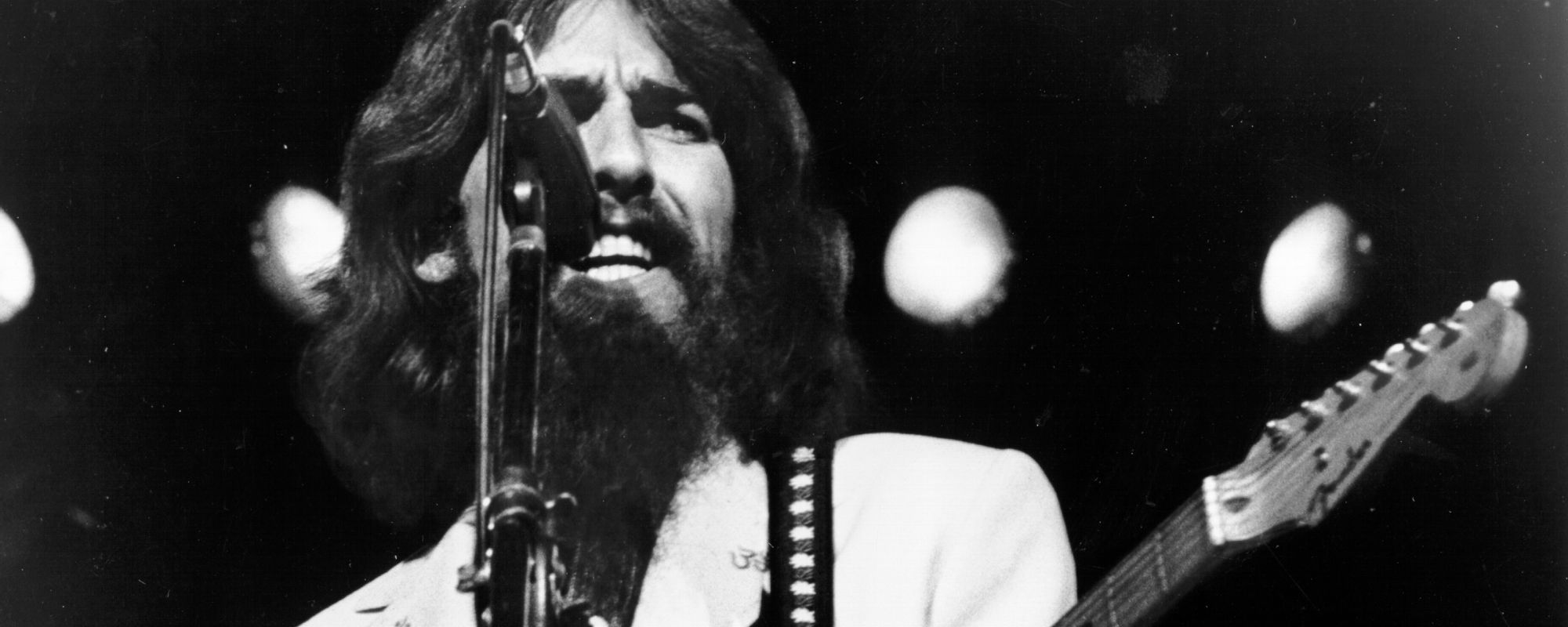One of the factors that made The Beatles so special was their willingness to do whatever was best for the song. In some cases, that meant putting aside their own instrumental gifts to do so. Case in point: George Harrison’s guitar work.
Videos by American Songwriter
When The Beatles came hurtling like a benevolent meteor out of Liverpool onto an unsuspecting world, Harrison was barely out of his teens but was already a master craftsman on his instrument. Realizing early that Lennon/McCartney songs didn’t need a lot of embellishment to make them special, he instead concentrated on developing parts that would enhance the overall effect without overwhelming it. Hence, he was more of an expert marksman than a gunslinger with his guitar work with the group.
You can point again and again to instances where a subtle touch added here or there by Harrison made a major difference. Here are five that stand out more than most.
1. ”I Need You” (from the album Help!, 1965)
Harrison didn’t just create guitar parts that helped only Lennon/McCartney originals. Although it took him a while to get there, he eventually became a major songwriter in his own right, and “I Need You” is perhaps the first great song he contributed.
On its own, it’s a sweetly melodic love song with some heartfelt Harrison vocals. But one of the key characteristics of the song is the effect that Harrison added to his guitar riff. Using John Lennon to push the volume foot pedal, Harrison’s Rickenbacker sounds as if it’s being refracted through a prism. He also makes sure to use the effect sparingly, lest it become a bit overbearing. It’s the perfect touch to elevate a relatively unassuming track into something magical.
2. “Nowhere Man” (from Rubber Soul, 1965)
This is a prime example of Harrison knowing just what to include in a song to make it perfection. And “Nowhere Man” is indeed perfection. Every word of the lyrics, every note played by the instrumentalists, all are necessary. It’s a finely-tuned mechanism of a song, one that might fall into pieces with a wrong move. Which is why Harrison’s decision to stick pretty much to the main melody of the song in the solo, playing the minimum of notes while doing so, is so important. Lennon played the same exact solo on the same exact guitar in unison with Harrison, giving each of those notes a little more power. The lack of ego from Harrison in allowing this, instead of just double-tracking himself, turned out to be crucial here.
[RELATED: 4 Recording Techniques Popularized by The Beatles]
3. “And Your Bird Can Sing” (from Revolver, 1966)
No one is quite sure what John Lennon is singing about on this song, catchy as those words may be. What we do know is that the song sounds terrific—a bright, shiny rocker featuring gleaming harmonies. And, as it turns out, we’re not only talking about vocal harmonies. To propel the song forward, Harrison decided to engage in a kind of guitar duel with Paul McCartney. Only instead of dueling solos, the pair play the main riff in harmony. They likewise harmonize the instrumental break together. The technique has been aped in a lot of songs since then (think Thin Lizzy’s “The Boys Are Back in Town” as one top example.) And we’re not sure if George and Paul were the first pair to do it. But we do know that “And Your Bird Can Sing” wouldn’t have been nearly as engaging without the inclusion of this part.
4. “Dear Prudence” (from The Beatles, 1968)
With “Dear Prudence,” it’s all about the buildup. Harrison’s lead guitar is nowhere to be found as this song begins, as he allows Lennon to set the table on vocal and acoustic guitar. As the song progresses, George starts to inject himself into the proceedings here and there. But by the end of the song, it’s Harrison who plays the crucial role of underpinning the melody with his electric fills. Without that, the extra frills, including McCartney’s maximalist drumming (Ringo Starr wasn’t at the session) and maniacal piano, would have been overkill.
5. “Come Together” (from Abbey Road, 1969)
Lennon famously intended this track to be a campaign song for the LSD proponent Timothy Leary, but his imagination got the better of him, and it became something else entirely. There are great instrumental touches throughout this track, including the electric piano part played by McCartney in the break that lent the song a bit of gritty feel. But Harrison’s parts here are essential as well. He’s in all the nooks and crannies, adding bluesy licks that accentuate the groove. He makes his presence most felt in the closing moments of the track, as his guitar keeps arching higher every time he’s prodded on by Lennon repeating the refrain.
Photo by Keystone/Hulton Archive/Getty Images












Leave a Reply
Only members can comment. Become a member. Already a member? Log in.